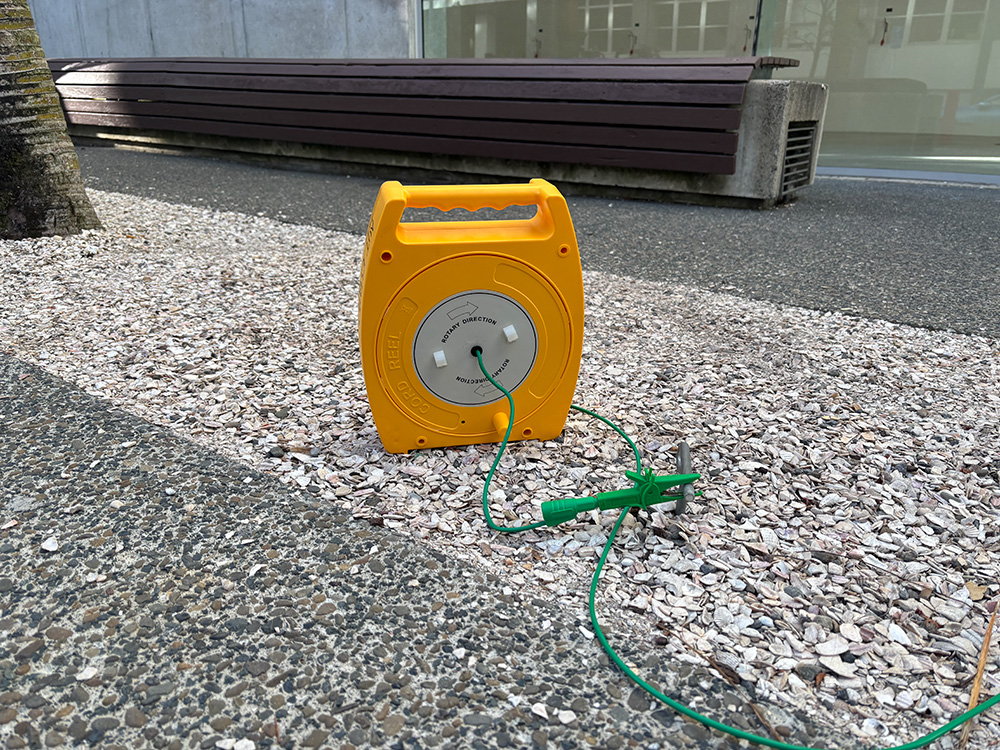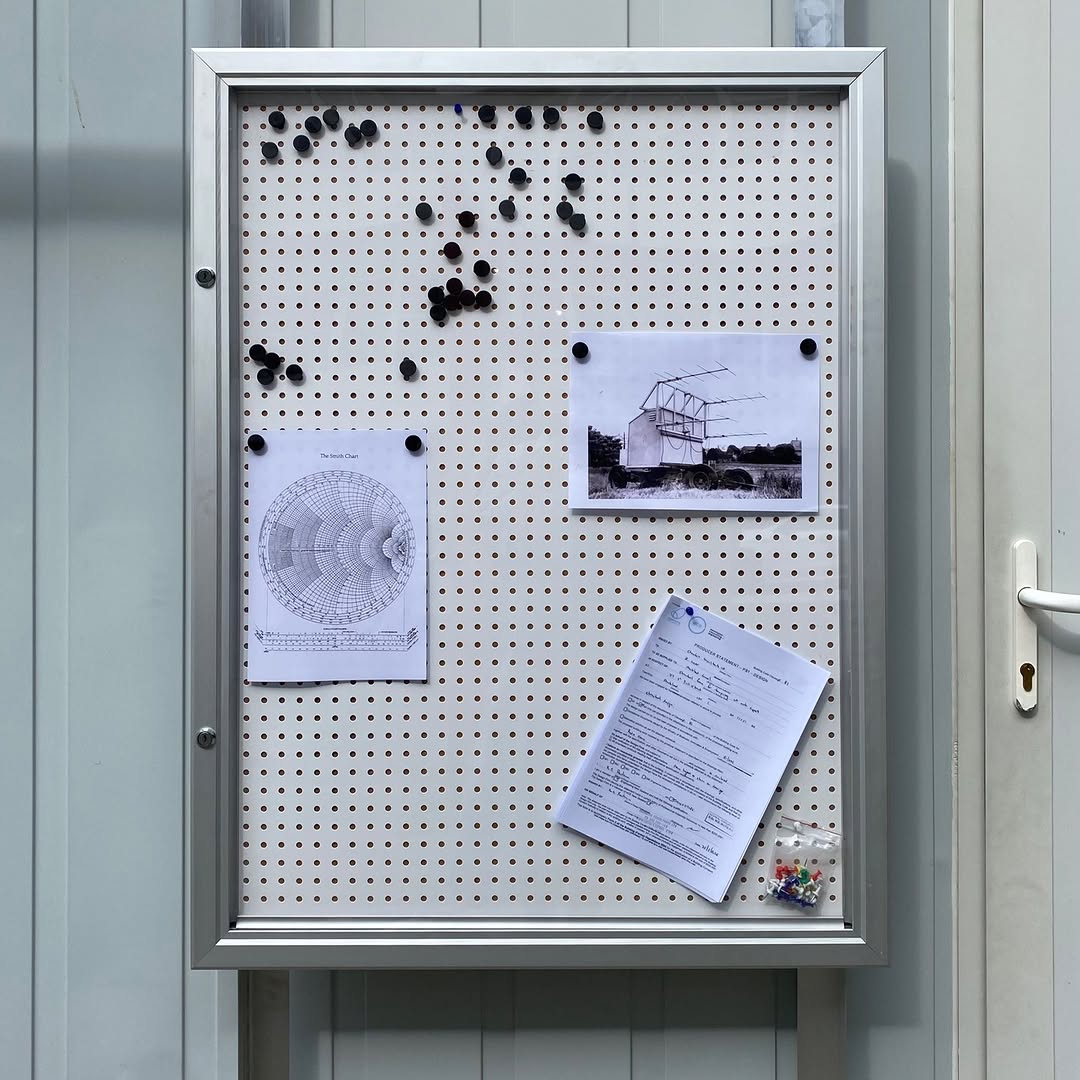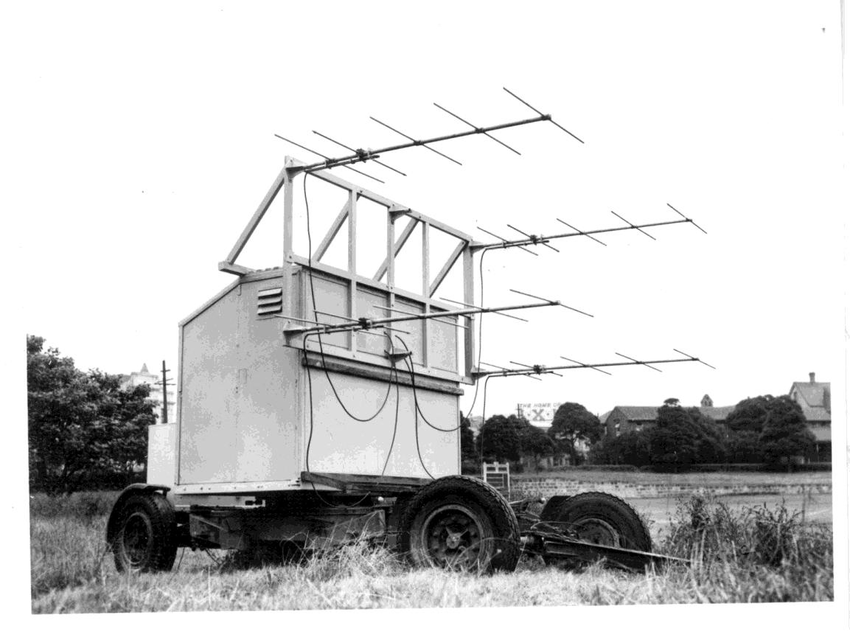

The Observatory Project, ASAP, 2025
Electromagnetic radiation (detectable from 500kHz-1.6MHz), LPAM radio wave transmissions, amplitude modulation (AM), portable container site office, Adaptable Sound Interferometry Equipment (A SINE), custom antennae, dipoles, AM loop, balun, transmission line, aluminium, antenna, hardware and fixings, field strength meter, gizmo, noticeboard, notes and notices, carrier waves, sidebands, CRT monitor, video (duration variable), custom printed hi-vis vests, cabling (orange power cords, custom signal cable, antennae feed line), portable radios, galvanised metal workbenches, not-measuring events, whiteboard, clipboards, drawings, measurements, not-measurements, steel mesh (ground plane), plastic mesh chairs, bucket, tape (masking, aluminium, and measuring), alligator clips, UNI-T frequency generators, site office computer, signage.

ASAP site office being loaded onto site

Getting to ground
At 7am on a clear autumn morning, The Observatory Project’s site office arrived. With surprising efficiency, a truck backed into a narrow courtyard entrance and elevated the 6 x 2m container into the air, gently guiding it to its destination at the shared entrance of the Gallery and the School of Art and Design. At odds with its stately setting, numerous onlookers queried; ‘What’s going on?’
Over the course of the exhibition this small structure will operate as a kind of ‘bootlegger’ radio station. In it the observatory houses a complex array of equipment, including their Adaptable Sound Interferometry Equipment (A SINE), and a series of modular sound generating sculptures housed within large steel cabinets. It also serves as a ‘plinth’ for an aluminium substructure which forms the station’s aerial, based on Bolton-Stanley’s interferometer (1948). Through this rudimentary and explicitly sculptural means, the observatory can broadcast across AM frequencies, and while restricted to the immediate vicinity of the exhibition, can sometimes override more established commercial and public radio platforms operating on the same frequencies. Their radio programming will include texts read by local radio presenters, interviews, recordings, and experiments with ‘not-measuring’ events, a methodology that the pair have developed over several years which deliberately blurs the lines between scientific and artistic models of observing and collating data.
The building is branded ‘ASAP’, announcing an on-demand model atypical of the strict schedule-focused culture of radio. In this sense, they provoke thought about how responsive and experimental radio could be if untethered from its rigid durational methodology. The installation’s distinctly provisional quality also enables it to shift and morph according to the observatory’s activities, which includes sea-cliff interferometry, ‘not-measuring’, provisional making, and documentation of machine calibrations.
Formed in 2017 after encountering gravitational wave sonifications, The Observatory Project is a collaborative project led by Auckland-based artist Ziggy Lever and musician and artist Eamon Edmundson-Wells, which explores making in relation to scientific processes. Their projects operate at the intersection of art and science, by using sound, video, custom made electronics, and sculptural installation as a means to diagram, interpret, and imagine scientific processes of observation. Their projects, while often occupying galleries, have popped up in specialist labs around the globe, including the Acoustics Research Lab, Auckland; Bidston Observatory Artistic Research Centre (BOARC), UK; and the Large Hadron Collider at CERN, Switzerland.
Roomsheet text by Stephen Cleland
Very special thanks to Bridge Shoebridge and Rachel Ashby for reading the text for ASAP!

ASAP noticeboard. Photo by Nat Tozer.
Upcoming not-measuring events: (click through to see documentation of each event)
Tuning in: Week One

1948 Bolton-Stanley Interferometer
Part of A Time of Waiting at Te Wai Ngutu Kākā Gallery
The Observatory Project, Layne Waerea, John Vea, Public Share, Kalisolaite 'Uhila, Jeremy Leatinu’u, Ena Kosovac, Chris Braddock, Shannon Te Ao, with forthcoming projects by Olivia Webb, Louise Pōtiki Bryant, Luke Shaw and Madison Kelly
Curated by Chris Braddock, John Vea and Stephen Cleland
04 April – 23 May 2025
Project supported by AUT’s Art and Design Research Fund and Creative New Zealand Toi Aotearoa 